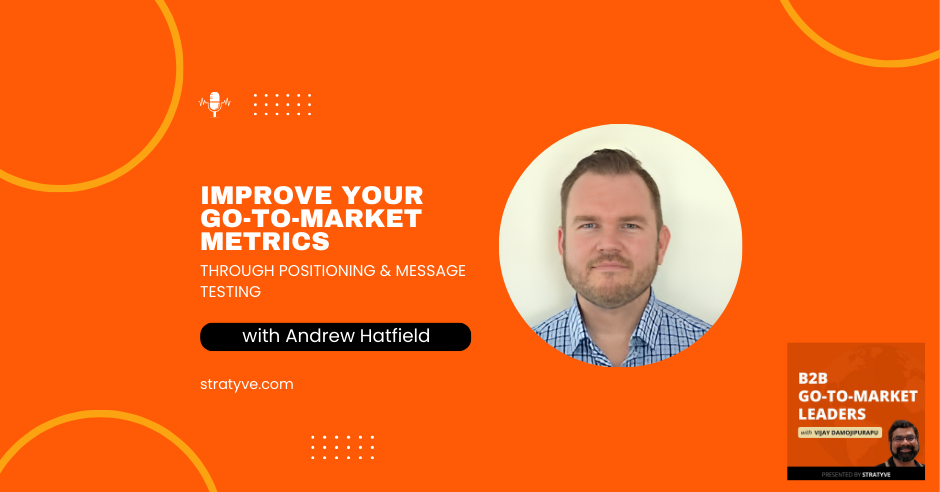
Dive into the latest episode of the B2B Go to Market Leaders podcast, where Andrew Hatfield who has a background in technology and product marketing, discusses the importance of aligning product, marketing, sales, and customer success functions for effective go-to-market (GTM) strategies. He highlights the role of product marketing in bridging gaps between these departments and ensuring that products meet market demands. Andrew also shares insights from his career journey and the challenges CMOs face in budget allocation and decision-making.
This episode provides valuable insights into the complexities of go-to-market strategies, the importance of alignment between teams, and the benefits of continuous learning and diverse experiences in achieving professional success. Whether you’re a seasoned professional or just starting out, there are lessons to be learned from Andrew’s journey that can help guide your own path.
By embracing adaptability, strategic planning, and continuous learning, you can navigate the challenges of your career and achieve success in the go-to-market space.
Listen to the podcast here:
Improve your Go-To-Market Metrics through Positioning & Message Testing with Andrew Hatfield
Signature question: How do you view and define go to market?
Yeah. Look, I look at what we have, you know, our company has this business strategy of the things that it’s trying to achieve and the go-to-market feeds directly from that. It’s the strategy and tactical execution of, how you acquire, keep, and grow revenue-generating customers while also ensuring that you keep alignment of the metrics and the integration with that broader strategy across products, marketing, sales, and customer success. So I definitely see that go to market is an integrated piece with the overall, goals of the company. It’s not just something that’s that stand alone. I do see that in many places that it’s just marketing is off on its own. it has to be, you know, hand in glove with the overall business goals.
Yeah. And I love the fact that you called out product in there because at least 30, 40, or even 50% of the guests that I spoke with, inadvertently omit the product side of the house.
I mean, you talk about go to market, and if you omit product, that’s a big mess for me.
Yeah, no, I see it all the time. For me, I come from a technical background, so it just feels natural. But yeah, definitely, you can’t go to market without working with product, sales, or even Customer Success. It just doesn’t work. The more I do this, the more I study this field, and the more I talk to organizations that are growing and winning, the one thing that really stands out is that there is a tight alignment between those different functions. The teams that don’t have that alignment have issues. Yeah, yeah.
I mean, athletes, and often we keep hearing about marketing and sales alignment and our misalignment, if you will. Right? I mean, a lot of topics, a lot of chatter on social media and even offline forums and communities. But then how about the alignment across product marketing, sales and even supporting customer success? These are all functions that happen.

But absolutely, you know that this exact conversation of had many times in the past two months of yes, lots of people are acknowledging the need and the unfortunate reality of the the misalignment between sales and marketing. You know, like often you see sales. We hit our league goals. Yay! And you know I’m sorry. Marketing hit their league goals.

But sales are sitting there going, I didn’t get good leads like I’ve missed my revenue number. I didn’t get opportunities from there, let alone qualified ones. And so like it’s good that we’re talking about this and that where we’re doing something about it. but similarly, we need to ensure that there’s alignment between the product and go-to-market. And, you know, like that communication has to go both ways. it’s not just product telling go to market. It’s not just go to market telling product, their partners right. Like that.
There is this saying in product marketing that, you know, product management, builds the like, puts the product on the shelf, and product marketing gets it off the shelf, which is not great.
But in some respects, there is truth to that. Right? So, you know, you wouldn’t have a go to market without a product and you wouldn’t have a successful product without a successful go to market. So yeah, they’re equal partners just as marketing and sales are.
Yeah. And on that topic of misalignment or miscommunication, I often see product and marketing not talking often and early enough, especially when you’re looking to launch a brand new product or a major doing a major launch. It’s super important for the product. And more often than not, it’s product marketing. But the functions and teams have to work hand in hand from early on versus, hey, we’re one month out from launch, let’s pull in. Product marketing or marketing?
So many times product marketing is always fighting to get a seat at the table. And increasingly they’re being invited, which is which is awesome. I think that product marketing is the secret weapon that, more people would benefit from. and it’s not that product marketing wants to be there and take over.
Right. But there are skills that they have and, you know, the earlier in the product, you know, ideation phase that you can bring in those skills, the better. Like, there’s, there’s often this discussion about, you know, for early-stage companies, when what role should they hire first, should it be a growth marketer or a head of sales? I argue that if you don’t already know, you know your positioning, your story, your segmentation, what is it that those people are saying and to whom? So it doesn’t have to be that it’s a dedicated product marketing function, but the activities that a product marketer does need to be there. it’s like the foundations of business, right? It’s not nice to have if you don’t know who you’re selling to and, and why they should care that that that’s not it’s not optional. Yeah.
Very cool I know we’ll be getting into more of these topics in the conversation later on. switching gears and big picture conversation and more around you.
Like what’s your career journey like and what led you to what you’re doing today?
Yeah, so I actually started my career in tech. You know, my parents owned software companies. And so, I started as a programmer. I loved that. And then I really fell in love with, like, deep technical, like, operating system stuff. I became a systems engineer and moved my way through that career into solution architecture, then into pre-sales and sales overlays, and eventually into product marketing. And now here I am running our product marketing and growth agency, Deep Star Strategic. the thing that like, really drives me and like how I’ve moved through those kind of like three big bucket stages is I’ve always had this understanding that like the, the technical thing that I’m doing is to support the business. So, you know, when I was writing you know, applications. It was business apps. Not infrastructure or IT apps. And so it had a direct impact on invoicing or the ability of sales folks to, you know, process an order or find inventory.
Excuse me. and so I took that same view when I was in that infrastructure role of like, yes, the infrastructure was super important, but it supported the applications which supported the data so that the business could actually function. And, you know, taking that even further of excuse me and taking that even further to, you know, the businesses there to serve their customers problems. So like this, this theme has just really been with me the whole time. And so, I remember, you know, when I’d start working with a new salesperson in, in pre-sales or even, you know, as a sales specialist and overlay, I’d always like, sit them down first and say, look, Tim, we’ve not worked together like I hear great things about you, but I don’t work like most of the other people. Like you’re going to sit there in this meeting and think, what are you doing, Andrew? You’re going around this, you know, garden path, like get to the point.

But it’s always about how can I really uncover what I now know to be unmet needs in the jobs-to-be-done framework. So it’s really that that focus on what it is that we’re trying to do and why that matters. And I think the thing that’s really helped me be able to do that, like my overall career, like I’ve constantly been told, Andrew, you need to specialize and be like this expert in this one thing. And I’ve just always pushed back against that. I have been a really strong generalist, there are absolutely people who are better than me in every area that I touch, but I am fairly deep in many of those areas and have a good knowledge in more so that I can go and get the right resources or I can build the right team. Similarly, taking that same sort of approach to work for small businesses or work for enterprises, I’ve worked for end customers, I’ve worked for vendors, I’ve worked in the channel, and I’ve worked for the public sector.
Yeah. And so the thing that I think really sets me apart and has been able to, you know, drive my career is just having a really good understanding of my customer, of how they operate, what their lives are like, why they do the things they do, like how they do them. and that’s helped whether I’ve been in it in, you know, sales, marketing, or now as a business owner.
Yeah. No. Very cool. Yeah. I’m looking at your LinkedIn profile and as you said, right early on in your career, you started off as an engineer and then you moved on more into architect and solution architect roles. But then something happened. While you’re at Red Hat, you’re doing and playing the role of a solution architect. And then you moved more into sales, pre-sales based dev So talk to us about that transition and what prompted you or what what motivated you to make that move.
Yeah. Look, I loved my time at Red Hat. Built some really good relationships.
really interesting place. Certainly, at that time, it was going through a lot of growth. And. Yeah, like, it was just. I’ve always wanted to do more. Not that it was like, what’s the next thing? And, you know, always trying to jump, but how can I be more effective? How can I help the customer?
More so like every time I learn something in, say, software development or in infrastructure or architecture or then into, you know, looking after, you know, a product set in a, in a country of like, how do we, you know, sell this and grow it? It just kept expanding and like, it really is that paradox of knowledge that the more I learned, the more I realized there was to learn. And I always felt that to be better, I need to know these things. And so I’m a fairly determined person, and so I just, you know, continue to, to chip away at things. And, you know, I’d go and sit with, sales, like being a pre-sales architect.
It was, obviously you supporting, account sellers. And then because of that, ability, like, I’d been learning how to sell, I was very deliberate because it’s just it wasn’t originally something I was I was good at, I learned how to do that. And, ended up, you know, being in 100% club, you know, six out of the, seven years that I was at, at Red Hat because I just like, what is it that the customer is trying to do? And how can I connect this product and this thing to that? And just being really focused on that.
Very cool. And then after Red Hat, you moved into a product marketing and marketing side of the house. but something else I noticed is at NetApp. It was a mix of like business strategy, go to market. So tell us about that role and your experience being head of cloud strategy over there.
Yeah. Well, just to make that make sense, as I was moving my career through Red Hat, I really wanted to be involved in building something.
And so, you know, I was looking at product management roles and then, like, internally and externally. and I remember distinctly being in this hotel room because I was traveling, 70% for Red Hat at that point. and I had this call with, editor Sue at, at, at the time, mesosphere then Duke, he was head of he was vice president of product management and product marketing at mesosphere. And I’d applied and, you know, made it through to the final round for, a product management role. I was just talking to him, and he’s like, Andrew, I really think you’d be more of a product marketer. And I’m like, no, no editor. And we went back and forth things like, Andrew, I really think with your, your, focus on the market that product marketing is, is really what you want. So I took the hint and got the job. And, that was a fantastic learning experience. I love working with it. It was, it was it was hard, but just fantastic.
And so, again, like the, the, the work at NetApp, similar sort of story. Right. The same sort of reasons of how can we do that, but just at more scale. Right. So, yeah, I’ve, I never felt that I was naturally good at strategy. I think I gave myself a bit of a, a hard time there that, yes, obviously I’ve learned a lot of things, but, as, as I think through, like, how I’m, relied upon, it’s largely because of that ability to see the bigger picture of how things come together. And definitely part of that is the career history I’ve had, like in those different organizations, in those different roles and the different viewpoints that have those similar aspects. So yeah, that’s that’s how we kind of ended up, being that, you know, strategy, how do we scale? How do we take a product to market?

Yeah. And when anyone talks about strategy or their role involves a lot of strategy, I go a bit crazy.
I feel a bit uncomfortable because, okay, so cool. It sounds very sexy. Very cool. Don’t get me wrong. but then how are you actually showing the value of what you’re doing for the business? So my question to you, Andrew, is like, what KPIs or what were you measured against in that role?
Yeah. Look, I agree with you that too often strategy is pontificating in your ivory tower. And definitely there there are some good things that come out of that. But strategy without execution is just, you know, talking or it’s a piece of paper that sits in the bottom drawer. So, I’ve always looked at, okay, what is it we’re actually trying to achieve while it’s hit our North Star metric, it’s. Which then leads to revenue, right? revenue is the outcome of that. Yeah. so what are the things that we know lead to hitting that North Star metric? So, like in the case of NetApp, it’s storage under management. Right. Like it’s how much capacity a customer is consuming.
And so or how do you how do you look at the leading indicator for that? While it’s the sort of applications that you support for their business, like what use cases are you aligned with? what teams are you talking to? you know, what partners are you working with? And then like, from there, obviously there’s, there’s the, the, the traditional exile’s metrics of like, pipeline. you know, share of voice. and then obviously, how much of that converts? Yeah.
Got it. Pretty cool.
And then, you decided to take a completely different route and went on your own. So talk to us about that transition and the motivation again.
Yeah, it’s cool. Like, I did have, my own business, you know, back when I was. I can’t remember now, I think around 20, doing, you know, it security and network security. And look, that was that was an interesting learning. built a decent product, but just didn’t have the business experience, I wasn’t ready.
So this time around, like, really focused on how can I apply everything that I’ve learned, you know, without, like, over boiling the ocean? Yeah. And, yeah, like, it kind of started as a, you know, working full time. And, you know, what can we do on top of things? I had started just before Covid and then, yeah, Covid hit and it’s like, oh, wow. Yeah, things aren’t exactly going to plan. how can I make sure that I’m not just completely subservient to all these other things in the market? You know, the classic rich dad, poor dad of, you know, being an employee? you know, you’re at the whim of everyone else.
So how do you then move from employee to small business owner so that you can build a big business? Yeah. yeah. Like taking those sort of thinkings and, you know, started as a, you know, I’ll do a contract here or do a contract there and just kind of grew and grew and grew and then, you know, the needed more people.
And, you know, the company sort of grown. It was more than just me. So, yeah, like, we’ve tried to be deliberate and balance organic with, driven growth.
So got it. And what what do you guys do at, Deepstar Strategic? What are the services and what kind of clients do you work with?
Yeah. So effectively, like, if you boil it down, like we use lots of pretty words, but it’s product marketing and growth and the looping back to the beginning of this conversation, a large part of it is ensuring that go to market has that closed loop and integration across, you know, product marketing, sales, customer success with emphasis on the product to go to market side. we feel that that is definitely a strength because of, you know, in particular my background, but, similar the people that we, you know, have in our organization have those same sort of experiences. Yeah. but it’s also like that understanding of how customers buy and how it’s changing.
You know, the world is very different to 2020. Like we hear that all the time, but we kind of forget that it’s even more different than Then 2018 and 2012, and a lot of the playbooks that businesses rely on are built on the assumptions of a world that no longer exists. And so, again, aligned with background, we focus on on B2B. I don’t know a lot about B2C, so it’s B2B, it’s SaaS in the vast majority of cases. You know, we’ve got a very strong belief that the future of software is at the minute, as a SaaS delivery, and with a particular focus on, tech, SaaS, not not everything, but not necessarily like IT infrastructure, but like you’ve got a technical product. and that could be, you know, something like you have a, an aerial survey company using drones so that building management can, you know, look after their facilities, like we classify that like you’re using technology to, to build a product and a business.

Yeah. Primarily focusing on growth-stage companies. like, obviously we have a lot of interactions with earlier stage, you know, seed and really early start-ups, but a lot of like a lot of what we offer really fits that that growth stage where, okay, I’m now at a bit of scale, I’ve got some product market fit, but I’ve started to, you know, run into either some scaling problems or I’m now wanting to expand my segments or, you know, add on a new product or enter a new market or of now started to, you know, kind of hit that ceiling of, paid ads was great. And now it’s okay. That’s not enough. Right. So how do we tune that? In particular, lately, it’s been about how can we identify wasted spend so that everyone’s budgets are being cut. And often we see that you know, you know, go to market leaders, in particular, are just like, okay, your budget’s cut by 30%. We just cut everything by 30%.
Done. Yeah. And sure that that meets your internal, direction, but we know that that’s not going to be sustainable, right? Because there’s always at least, you know, 20%, often 40% of your spend. That’s just ineffective. And the problem is a lot of companies don’t know what’s ineffective, because again, going back to this, knowing your customer, and this isn’t necessarily just an argument about attribution or recognition of, you know, credit of like who brought in the opportunity, but what works, right?
And, you know, like I said, the way people buy now has changed. But a lot of the playbooks you look at waterfall, you know, the demand waterfall, it just doesn’t take that into account. So lately, a lot of what we’ve been doing is helping businesses apply that understanding and then identify spending that’s completely wasted. Yeah. And often they’re like, oh, I’m not sure if I want to go and cut that program and like, cool, why don’t we just
reduce it by a little bit for a couple of months? And often like nine and a half times out of ten, that program is ineffective.
There’s no change to any of the other metrics other than it going up. And so we’re able to say, look, why don’t we cut that a bit further and we’ll redirect that spending to something that is actually working will multiply that. And so, you know, helping customers with that ability to do less with less with a better result.
Yeah. And so pretty cool. So you’re helping them around their marketing budget and performance, marketing budgets, and so on. So who would you categorize or who do you see as your primary ICP the CMO, VP, marketing, growth marketer, CEO, or someone else?
Yeah. So typically we’ll focus on a B to D style, startup or that bigger enterprise where we’re working more with like a product division. at that larger side, it’s often the product, you know, revenue marketing or you know, sometimes performance or demand. Gen. Yeah. for that particular product line for the growth stage startup, you know, B2D typically it is we, we enter with the CMO and often talking with the head of sales.
Yeah. some startups still have the founding CEO, you know, sign off on everything. And so, you know, we build relationships, but most of the time the entry point is, is CMOs, for that particular, you know, service that we, we have, when we’re talking more around holistic go to market, definitely including more, you know, head of product, Chief Product Officer, as well as, you know, customer success and sales. But often that’s, a secondary engagement because like, that’s more of a it’s seen as a vitamin. I know that that is, is critical, to growth. But like immediately the pain that hurts the nail in the, the forehead that is, is, you know, keeping me up at night, which I hate that phrase, but the pain that they’re really suffering is all right. I’ve got this budget. How do I spend it to make sure that I keep my job right as a CMO and, you know, make sure that the spend is effective so that we actually generate revenue, customers, paying customers?
So yeah.
Very cool.
So, Andrew. Yeah. Thanks for walking us through your career transitions and the different motivations, as well as the services that you provide, with, your company today. on a lighter note, I mean, you’ve been through a lot. You’ve been through different stages and different roles. how does your family describe what you do for a living?
Earlier, it was Daddy living on a plane. thankfully, like, 70% of travel is over. But, you know, I even asked my wife about this, and it’s like, well, we really don’t know, but we know you get up and work insane hours and you help companies, you know, help their customers. Yeah, that’s about it. It’s like some marketing thing. so the, you know, I’ve got some, some young kids, you know, you know, 12 to 7. They’re very inquisitive. They think it’s really cool that daddy talks to lots of people around the world and, you know, balancing that business and tech and, you know, like, the kids would come to me and try and tell me about how things work on their iPad.
And I’m like, sweetie, you know, daddy used to work for the companies that build that thing, like Roblox used to be a client, like, no. So that that look on their face or like when they’re trying to tell me, like, I know there’s something wrong with the App Store and they can’t, you know, go and get an update. It’s like, daddy, do this. And it’s like, thanks, buddy. daddy used to do this stuff. So, they’re constantly amazed, which is amazing. I don’t expect them to understand everything. but yeah, like, it’s daddy does some, some cool stuff to, to help other people do their stuff. Which which I think is nice.
Yeah, that was very funny. I mean, hearing your wife or kids say, hey, that used to be on planes and he’s always traveling versus now they see the other side. Which is your app working with clients from all over the world. So that leads me to another question, which is like, where are your clients mostly based out of, and how do you manage the whole time zone difference, given that you are in Australia and in Brisbane?
So when the joke at Red Hat, even though I look after APAC, was that Andrew never sleeps, which was not true. just clever marketing. and internal, relationship management. when I left Red Hat and started working for Mesosphere and a number of other Silicon Valley, startups, you know, I’m in Brisbane, I’m in Australia. It’s an 18-hour time difference. I often joke that I’m from the future. Sadly, it doesn’t help me with the stock market. but, you know, that has challenges, right? Like America and North America is the world’s largest market. That’s where most of the tech firms are most of the people that I would look at as either clients or potential partners. And so I just decided that I’m no longer going to be a night owl. I’m going to be an early bird. And so I get up for a 4 a.m. local start to align with, you know, 10 or 11 Pacific. Yeah. and that’s worked really well. Like, I was surprised the first couple of months was really difficult.
But I’ve been doing this for six, six years now, like that, those sort of working hours, it gives me incredible freedom to work with great people, but also still have a lot of balance with, with family. Like, I go to the gym in the afternoon, 3 or 4 times a week. I can pick up the kids. so that’s really good. That actually, like, the weird working hours actually works better for our family. you know, working from home helps as well, right? In terms of the clients, look, a lot of them are in the US. some of them are, you know, every now and then, like we’ll get a European customer, which is great. That does mean it’s it’s often late hours for for face time. but, you know, one of the things, you know, when I decided, you know, deep star strategic is going to be more than kind of like a side hustle where I do some contracts and like a real business.
The, founding like philosophy was there are so many great ideas that fail because they can’t execute. And for some of that, it doesn’t matter what go to market is, it’s just not a viable product or company. Right. but those that are like, there’s still a large number that fail. And so a lot of the time it’s because you’ve got, people that are great at the thing but don’t understand or have those skills of how to actually grow the business.
And so how can we help them? so there is like a real soft spot for an Australian audience and a lot of, you know, Australian startups like we really do like punch up and, punch above our weight. in terms of, you know, the relatively small talent pool and capital in Australia compared to North America, like we’ve got some great companies. Like there’s Atlassian, there’s there’s Canva, Safetyculture, you know, Xero, like their global brands. And often a lot of those companies as they look to scale, from Australia, want to serve a US market.
And, you know, we have a lot of experience in that. So, look, we aggressively go after and focus on the Australian market. but a lot of our clients, just through the nature of where they are, are in the US, and we find that, that again, that, that, that diversity, not just from a business risk perspective and, and revenue, but just keeping your hand on the, the pulse of what’s happening is, is really good. And obviously, the experience of having worked across Australia, Asia Pacific, and the US, is something else that differentiates us in the local market. conversely, American companies that want to enter the Asian market often, you know, North Americans kind of see Asia as just one amorphous blob that looks the same. It is very different like it’s very different to Europe. there are not just lots of countries. There are lots of time zones. there are lots of different cultures. You know, you look at, a lot of Asia, like Japan in particular.
You have to go through partners. The same in Vietnam, and Thailand, very similar in Singapore. but then interestingly, like in Japan, the customer cares about their relationship with the partner far more than the vendor. And so there’s a lot of these things that are so different to how business works in North America that, you see a lot of companies fail in the. Yeah, the Asian expansion. Yep. So, yeah, those things help too.
Yeah. No. That’s good. Good. Getting a wide perspective, starting from how you plan your day and working with the different time zones, and giving advice to folks who are looking to enter the Asian market. switching gears here, as you and I know, Andrew go to market is not just success or not just failure. It’s going to be a mix of both. So if you can share a go-to-market success story and a failure story, I’ll let you pick which one you want to go with first. Yeah.

So, a success.
so I won’t use any names. because there’s, there’s obviously details, but, you know, a large tech company that we’re working with, they were successful in their own right. They had a good and growing product that was in a cloud, you know, hyperscalers marketplace, which, you know, was good. However, the third-party marketplace introduces a lot more hurdles to an end customer. Like there’s there’s different billing, there’s different contracts, there’s different procurement.
You can’t draw down on the cloud credits that, you know, you go and get a contract with them like it’s a separate, amount of money, you know, supports different. And so that was starting to hinder them. And so, you know, working with them, we’re like, okay, why don’t we see if there’s appetite with the, the cloud provider to make this a first-party service, which is a massive hurdle. So, you know, that that kind of snowballed and, had a lot of like, senior executive, you know, up to the point of, you know, CEO conversations between, you know, those two parties and moving big machines is really hard.
And so, just trying to make it, you know, okay, cool. Like, we’ve got this big dream, but like, let’s just, like, make sure we’re getting this done. Yeah. and so, yeah, like, last year, working with them to take that product as a first-party service. So it’s now like owned and operated by that cloud vendor, or there’s joint product and joint engineering. there are individual and joint go to market. you know, sales enablement is joint and individual. They both have sales teams, but there’s a lot of like they work together. because there’s obviously more than what that other company sells inside of, the cloud provider. like that, that that was really hard. 6 months later, there’s still a lot of work to do. This is still a teething problem, as you can imagine. Like that. That’s not an easy thing. but, you know, like a lot of those customers that were on that third-party service, you know, transitioned, which is good because, you know, enterprise companies, you can’t just, you know, announce to them that, oh, hi, we’re completely changing how you consume the product.
And can you do it tomorrow? Right. so that’s really good. So the feedback from both existing customers and net new. And so there’s good growth on that side as well. and yeah like that’s the the the growth rate is significantly higher from the the first party side to the, the marketplace, which was the goal. So things are all moving up to the right.
Very cool. And then what were your services and what did you specifically do? Was it more around alignment or, did you create content or collateral? So talk.
Yeah, a lot of so I was involved in that project. So a lot of what I was doing was around the content collateral and the joint selling efforts and that sales enablement and some of it was like helping educate customers around. Okay, so this is what’s changing why, and what you get out of it. Yeah. Other parts were okay just simply because we now have this co-engineered product. What. That opened up a whole heap of other avenues that we could, you know, build solutions for or use cases that we could serve that just weren’t available before.
And so okay what are those like identifying them and then prioritizing them both in their market opportunity and the ability of the sales teams to execute? and, you know, building, the collateral for that. So whether it was, you know, sales decks, you know, working with the revenue marketing team around campaigns, some of their other partners that they used, like, how do we involve the, the end like sales channel. partnerships that were, you know, partners, on both sides. So, yeah, a lot of the more on, the sales side, in terms of the execution.
Very cool.
And the salespeople are great Yeah.
So the other part of my question was a go-to-market failure story. And again, as you and I know, there’s nothing like a failure. It’s more of a feedback loop or a lesson. So if you can share a good idea that didn’t really pan out as planned.
Yeah. So a couple of years ago, I worked for a North American, I suppose you’d still have called them startup.
They were looking to IPO. They eventually got acquired. they had been the market leader for many years in, in IT automation. And I had some experience doing that, with a competing product at Red Hat that kind of helped dethrone that company. So it was really interesting. going to the other side of what was the leader then started to lag. I joined them because it looked like they were like trying to do some things to turn this around. And they wanted help. They wanted that, that other perspective. and so that that seemed so promising.
And there was definitely eagerness on the south side to kind of stem that tide and tell a more modern, up-to-date story. But even with a new head of product that was very experienced, there was still a lot of reluctance on the product side to, you know, just acknowledge that the impact to technology that cloud has had and how it organizations in particular, you know, now run their ops, let alone the integration of, of dev and then DevOps.
So that was really difficult, that there’s no point in telling a story that you can’t deliver on. Like storytelling is super powerful, and it allows you to set a bigger picture that you can take your buyer or customer down, you know, nine out of ten steps, but you can’t, you know, get over your toes too far. otherwise, it’s the vaporware. And like, you lose credibility so you can set a big vision as I look. We can take you three-quarters of the way, but we’re like, in the next two quarters, we’re going to finish it. Right. And as long as you deliver on that and you’ll, upfront, that’s okay. But yeah, there was such a big difference between the stories that we wanted to tell that we, you know, you know, smart technical people that, you know, been in that segment for a long time and, you know, others in the go to market team that, you know, okay, this is what customers are telling us.
Yeah. There’s still such a big divide between that and, you know, product and engineering. what’s even more unfortunate is they had this whole new idea in a product that they had started, but it was then driven by the CTO. It was outside of product and, like dedicated engineering. And that was amazing. Like that.
That was all around like helping infrastructure teams operate in an event-driven manner rather than a procedural which has so many possibilities. But it was really treated like a science experiment. And I’m like, hey, I know this is weird. Like, this is different, but like, there’s an opportunity here and like connecting all these dots and like, you know, showing them, you know, giving the leadership team the, the details of customer interviews that we’d had or showing them like, this is what the impact would be from a technology side and how that would translate into, you know, growth for the company. And they just didn’t see it like that. That was not the world that they were in.
And so I would count that as a failure of me to be able to, you know, lead those executive teams. But, you know, it’s it’s also hard. And this is the flip side, right, of alignment. You can’t talk about alignment and preach it and then be the one that goes rogue. Right, right. Like as much as you back yourself and you think you’re right, you know, as much as you might think that you’ve got all the information at hand, you know, often you don’t. And, you know, like I would say in this case, it’s unfortunate that that was amiss. they ended up, you know, like I said, getting acquired by a PR firm. yeah, I think there was heaps of opportunity there. And I would say that that was partly me, partly the market, approach that, that leadership wanted to take. Yeah.
Very good. Yeah. Practice what you preach definitely applies to go-to-market marketing, sales, alignment, or alignment across any functions for that matter.
And equally applies to parenting as well.
Yes, as much as you like, but I know. Yeah. yeah. Look, no one, you know, has all the answers. And like, while I do have that, that breadth of experience, the thing that it has taught me is you need the people around you and you need to take them with you, or you need to be going with them, right? Like. Like I said, you can’t go rogue, no matter how well-intentioned or justified you think you are. So.
So in terms of staying up to date, when it comes to go to market, like what people, community resources, books, podcasts, or anything for that matter, what do you lean on?

yeah. So I love to learn. I am constantly interacting with, you know, people that I think are less experienced or more experienced or smarter or, like, just I want to learn from everyone. so a lot of LinkedIn and LinkedIn and, and X or Twitter, there’s great conversations in those places.
I like to, you know, I’m, I’m a big contributor to the Product Marketing Alliance. I’m an ambassador there. And so that’s been really helpful, just getting access to a lot of other smarter people. And, you know, I kind of have a couple of podcasts that I like listening to. Like cheekily, I do quite like yours. so love that I’m here. That feels really awesome. you know, Dave get hearts, you know, exit five podcasts. Jay closes, you know, creators. but yeah, like, how can I get views and experiences from people that are adjacent to what I’m doing, that are doing the same things that I’m doing or touching and sometimes just completely different?
Like I remember years ago, like I was I was a young adult, you know, I was at uni doing, you know, an IT degree and, software engineering and, data communications. I was a young boy that, you know, played on computers and, you know, mucked around like a little bit of games, but lots of like, how can I go and improve the Linux kernel? very aspirational.
and then, you know, like my world just revolved around tech. I was working full-time in tech as well, and like, I wanted something different. So I went and became a waiter at a busy cafe. And so even that, like, made me better. So I’ve definitely got this understanding that there’s lots to learn from outside, the field you’re in. So, you know, one of my mentors, he’s an Olympic Stadium architect, like I’ve learned so much from him. Has nothing to do with the fields that I’m in. And yet the lessons have, you know, massively multiplied my income in the last, you know, ten, 15 years. So, you know, just that appreciation that, yes, you want to take in lots of things and filter them, but also not limit yourself to your domain. So. Right.
Yeah, I’m glad you actually touched upon that point right when I asked you for resources and a community of people that you lean on, I’m glad you touched upon.
Hey, it’s just not this domain. And more often than not, I do that myself, which is I listen to the podcasts that are outside of or have nothing to do with go to market. Maybe it’s about writing, maybe it’s about presentation, maybe it’s about entrepreneurship, or maybe it’s about finance. Completely different topics, or just having fun conversations on very topics. And that’s really critical, especially to wind down and give that rest period to your brain for more ideas to formulate.

Yeah, absolutely. There are a couple of things you hit on there that I agree with, right, that you need to have that balance. Like just knowing everything about one thing makes you a dull boy. And so just personally, you know, when you’re talking with friends or trying to socialize, you’re boring, like have other interests. like, I love to barbecue, I love to cook, I love to snowboard. you know, I work out a lot with a lot of, weight training. lately, I’ve been learning about the carnivore diet.
That’s what’s been working. But, yeah, I love meat, but can’t just have steak and eggs all the time. So, like, what
else does that involve? so. Yeah, and like, like, we, we kind of, I think we’re arguing in furious agreement about you will be better at the thing you do by learning about other stuff as well, because there’s lessons that are applicable universally. Yeah, for sure.
And a final question to you is if you were to turn back the clock and go back in time, what advice would you give to your younger self on your like on day 1? If you go to market journey.
No matter how fast you’re moving, you can always move faster and learn faster. don’t try and like do everything at once. And so like in line with that. Like moving faster. do it with smaller steps and like, really focus on on connecting those dots between things. I think that’s, the thing that I would say, like I am even now, like whenever we run a new campaign, I’m amazed that it works.
I don’t think I’ll ever get over that feeling. I think it’s so weird. Like, I’ve done this a while now and I’m still amazed. Right. and, like, you know, my career, I’ve been working since 96. across all those different areas. Like, I’ve learned a lot of stuff. And even there, like, I’ll still, like, talk with my wife, like, I got, like, this much done today. and like, I, I recognize this. I don’t know how to get over this, but I’m just constantly blown away by just the, the, the the speed and the volume of output that I’m capable of achieving And, you know, I don’t expect that of everybody. Like I’m the CEO, the business owner. Like, it’s, like my baby, you know, people, you know, work hard, but, yeah, just constantly amazed by just how, how much that you’re able to get done. but, the lesson really is knowing how to identify what the right work is and just do it faster, and learn faster.
